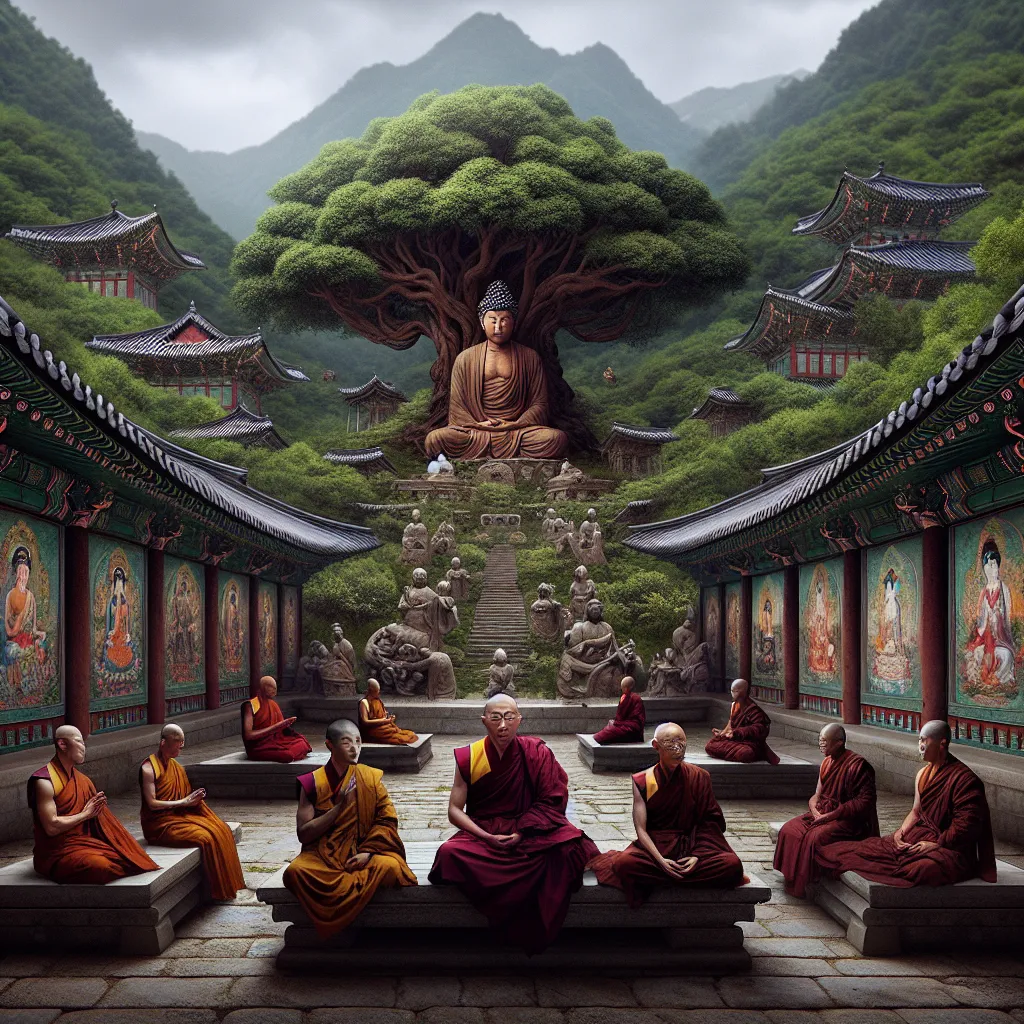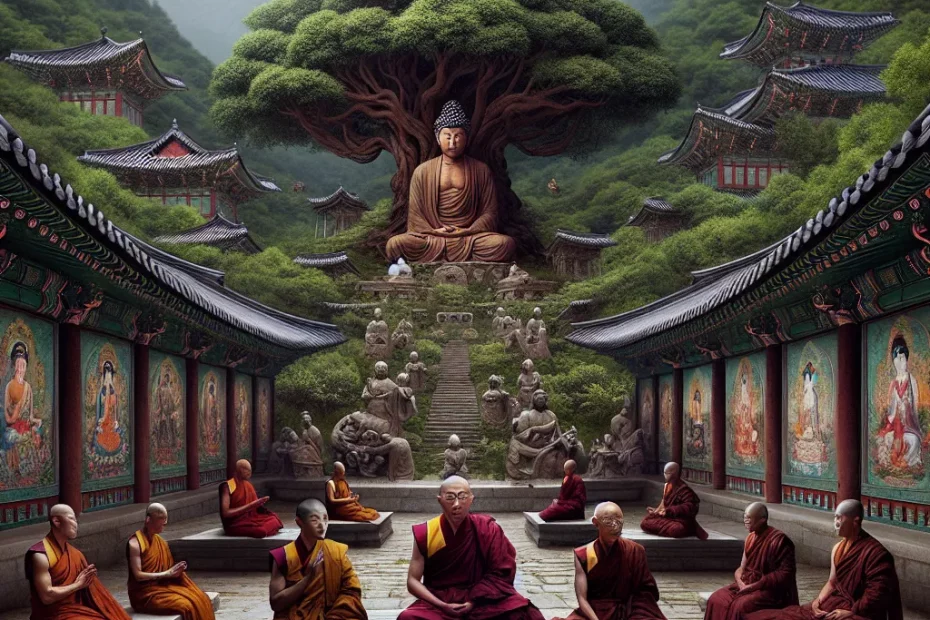Buddhism has played a significant role in shaping Korean culture, leaving a lasting impact on everything from architecture to art. The introduction of Buddhism to Korea marked a pivotal moment in the country’s history, leading to the construction of numerous temples that still stand today as testaments to this rich heritage. The influence of Buddhism on Korean art can be seen in the intricate designs and spiritual themes that permeate traditional paintings and sculptures. Today, there is a modern revival of Buddhism in Korean culture, with a renewed interest in its teachings and practices. This deep connection between Buddhism and Korean culture continues to be a source of inspiration and reflection for people around the world.

Buddhism’s Introduction to Korea
In the early centuries, Buddhism made its way to the Korean peninsula, bringing with it a rich tapestry of culture, art, and philosophy. The introduction of Buddhism to Korea can be traced back to the 4th century, during the Three Kingdoms period. It was through the maritime Silk Road that Buddhist scriptures, artifacts, and teachings found their way to the shores of Korea, captivating the hearts and minds of the people.
The First Official Introduction of Buddhism
The first official introduction of Buddhism to Korea is credited to King Beopheung of the Silla Kingdom in 372 AD. Under his reign, Buddhism began to take root, eventually becoming a central pillar of Korean society.
Buddhism’s Influence on Korean Art
Temples began to dot the landscape, serving as centers of worship, education, and community life. These temples not only housed precious relics and scriptures but also became hubs of artistic expression, with intricate carvings, paintings, and sculptures adorning their halls.
Buddhism’s Impact on Korean Literature and Philosophy
Buddhist teachings also had a profound impact on Korean literature and philosophy. The concept of impermanence, the interconnectedness of all beings, and the pursuit of enlightenment became central themes in Korean literary works and philosophical discourse.
Transformation of Buddhism in Korea
As Buddhism took root in Korea, it underwent its own unique transformations, giving rise to distinct Korean Buddhist practices and traditions. The spread of Buddhism throughout the peninsula led to the construction of magnificent temples, the establishment of monastic communities, and the flourishing of Buddhist scholarship.
Legacy of Buddhism in Korea
Today, the legacy of Buddhism’s introduction to Korea can be seen in the countless temples that still stand, the vibrant art that continues to inspire, and the profound impact that Buddhist philosophy has had on Korean culture and society. Buddhism’s journey to Korea was not just a historical event but a transformative force that shaped the very essence of Korean identity.
Spread of Buddhist Temples
In the rich tapestry of Korean culture, the spread of Buddhist temples has played a pivotal role in shaping the spiritual and artistic landscape of the country. With a history dating back over a millennium, Buddhism has left an indelible mark on Korean society, influencing everything from architecture to art, and even daily rituals.
Origins of Buddhist Temples in Korea
During the Three Kingdoms period in Korea, Buddhism began to take root, with the construction of temples and monasteries becoming a common sight across the land. As the religion spread, so too did the architectural style of these temples, characterized by intricate wooden structures, colorful paintings, and ornate carvings. These temples served not only as places of worship, but also as centers of learning and culture, attracting scholars, artists, and craftsmen who contributed to the flourishing of Korean arts.
Legacy of Bulguksa Temple
One of the most famous temples in Korea is Bulguksa Temple, located in Gyeongju. Built in the 8th century, Bulguksa Temple is a UNESCO World Heritage Site and a prime example of traditional Korean temple architecture. With its stunning pagodas, stone lanterns, and beautiful gardens, Bulguksa Temple stands as a testament to the skill and craftsmanship of ancient Korean artisans.
Influence of Temple Art
As Buddhism continued to spread throughout Korea, so too did the influence of temple art. From intricate paintings depicting Buddhist deities to delicate sculptures of Bodhisattvas, Korean temple art became renowned for its beauty and spiritual depth. The blending of Buddhist themes with traditional Korean artistic techniques created a unique aesthetic that continues to inspire artists and art lovers to this day.
Community Role of Buddhist Temples
In addition to their artistic significance, Buddhist temples in Korea also served as centers of community life. Monks and nuns residing in these temples played important roles in providing spiritual guidance, education, and even medical care to the local population. Temples became hubs of cultural exchange, where people from all walks of life could come together to pray, learn, and celebrate.
Today, the legacy of Buddhism in Korea lives on through the countless temples and monasteries that dot the country. Each temple tells a story of devotion, artistry, and cultural exchange, reflecting the enduring influence of Buddhism on Korean society. As visitors wander through the halls of these ancient temples, they are transported back in time, experiencing firsthand the spiritual and artistic richness that has defined Korean culture for centuries.
In conclusion, the spread of Buddhist temples in Korea has not only shaped the physical landscape of the country, but has also enriched its cultural heritage in profound ways. From the majestic temples nestled in the mountains to the intricate artwork adorning their walls, the influence of Buddhism is woven into the very fabric of Korean society, serving as a reminder of the enduring power of faith and art in shaping our world. 🌸🏯🎨
Buddhist Influence on Korean Art
Exploring the rich tapestry of Korean art unveils a profound connection to Buddhism, a spiritual tradition that has deeply influenced the country’s artistic expression for centuries. From intricate temple murals to exquisite sculptures, the presence of Buddhism is woven into the very fabric of Korean artistic heritage. 🎨
Temple Architecture
One of the most striking manifestations of Buddhist influence on Korean art is seen in the architecture of temples. The graceful curves of traditional Korean temple roofs, known as “dancheong,” are adorned with vibrant colors and intricate patterns that symbolize the Buddhist cosmology. These architectural elements not only serve as a visual feast for the eyes but also carry profound spiritual meanings, reflecting the Buddhist principles of harmony and balance. 🏯
Korean Paintings
In addition to architecture, Buddhist themes are prominently featured in Korean paintings. The Goryeo dynasty (918-1392) is renowned for its exquisite Buddhist paintings, which often depict scenes from the life of Buddha, bodhisattvas, and other divine beings. These paintings, characterized by their delicate brushwork and ethereal beauty, serve as visual representations of Buddhist teachings and provide a glimpse into the spiritual world of ancient Korea. 🖌️
Sculpture
Sculpture is another art form deeply influenced by Buddhism in Korea. The country is home to numerous Buddhist statues, ranging from small portable figures to colossal stone carvings. These statues, crafted with meticulous attention to detail, embody the serene and compassionate qualities of Buddhist deities, inviting viewers to contemplate the divine presence in their midst. The iconic Seokguram Grotto, a UNESCO World Heritage site, houses a magnificent Buddha statue that exemplifies the sublime beauty of Korean Buddhist sculpture. 🗿
Decorative Arts
Furthermore, Buddhist influence can be observed in the decorative arts of Korea, such as ceramics and textiles. Celadon pottery, known for its elegant green glaze, often features Buddhist motifs like lotus flowers and dragons, symbolizing purity and protection. Traditional Korean textiles, adorned with intricate embroidery and symbolic patterns, reflect the spiritual beliefs and cultural values inspired by Buddhism. These art forms not only showcase the technical skill of Korean artisans but also serve as expressions of devotion and reverence. 🏺
In conclusion, the profound influence of Buddhism on Korean art is a testament to the enduring legacy of this spiritual tradition in shaping the cultural landscape of Korea. From the serene beauty of temple architecture to the exquisite craftsmanship of Buddhist sculptures, Korean art continues to reflect the timeless wisdom and artistic vision inspired by Buddhism. Through its intricate symbolism and spiritual depth, Buddhist art in Korea serves as a bridge between the earthly realm and the divine, inviting viewers to embark on a journey of contemplation and enlightenment. 🌟
Modern Revival of Buddhism in Korean Culture
In recent years, there has been a remarkable resurgence of interest in Buddhism within Korean culture. This revival can be seen in various aspects of society, from the increasing number of people visiting temples for meditation retreats to the growing popularity of Buddhist art and literature. The influence of Buddhism on Korean culture dates back centuries, but its modern revival is breathing new life into traditional practices and beliefs.
The Rise of Temple Stays
One of the most noticeable trends in this revival is the rise of temple stays among both locals and tourists. 🏯 Temples across South Korea now offer programs that allow visitors to experience the daily life of monks, participate in meditation sessions, and learn about Buddhist teachings. This hands-on approach has attracted people from all walks of life, seeking solace and spiritual growth in the serene surroundings of these ancient temples.
Appreciation for Buddhist Art
Furthermore, the appreciation for Buddhist art and artifacts has also experienced a resurgence in recent years. 🖼 Traditional Korean Buddhist art, with its intricate designs and symbolic meanings, has captured the imagination of art enthusiasts worldwide. Museums and galleries dedicated to Buddhist art have seen a surge in visitors, showcasing the rich cultural heritage preserved in these masterpieces.
Philosophy and Teachings
In addition to the tangible aspects of Buddhism, the philosophy and teachings of the religion have also found a new audience in modern Korean society. 📚 Books on Buddhist principles, mindfulness, and meditation have become bestsellers, reflecting a growing interest in incorporating these ancient wisdoms into contemporary lifestyles. Many people are turning to Buddhist practices as a way to find balance, peace, and meaning in the fast-paced modern world.
Reflection of Societal Shift
The modern revival of Buddhism in Korean culture is not just a passing trend; it is a reflection of a deeper societal shift towards mindfulness, spirituality, and cultural heritage. 🌟 As more people rediscover the value of these ancient traditions, the influence of Buddhism on Korean culture continues to grow and evolve, shaping the way people live, think, and create in the 21st century.
In conclusion, the revival of Buddhism in Korean culture is a testament to the enduring power and relevance of this ancient religion in the modern world. 🌸 By embracing the teachings of compassion, mindfulness, and interconnectedness, Koreans are not only preserving their cultural heritage but also paving the way for a more harmonious and enlightened society. The journey of rediscovery and revival is ongoing, with each new generation finding new meaning and inspiration in the timeless wisdom of Buddhism.
The historic influence of Buddhism on Korean culture is undeniable, shaping the country’s identity from temples to art. From the introduction of Buddhism to Korea to its modern revival, the impact of this ancient religion is deeply ingrained in every aspect of Korean society. The spread of Buddhist temples across the Korean peninsula not only served as centers of worship but also as hubs of education and culture. Korean art, influenced by Buddhist themes and aesthetics, reflects a unique blend of spirituality and creativity. Today, the modern revival of Buddhism in Korean culture continues to inspire new generations, highlighting the enduring significance of this ancient tradition.
